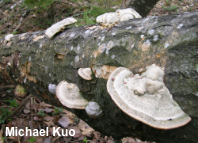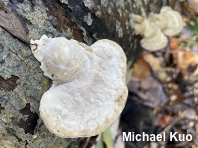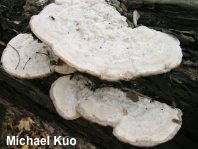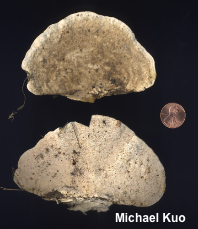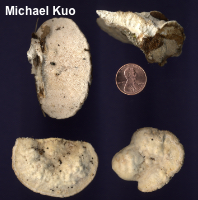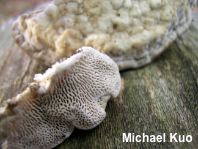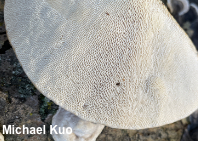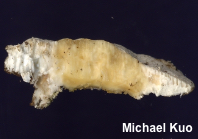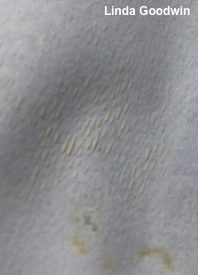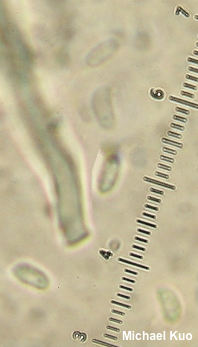| Major Groups > Polypores > Trametes gibbosa |

|
[ Basidiomycota > Polyporales > Polyporaceae > Trametes . . . ] Trametes gibbosa by Michael Kuo, 30 March 2023 This Eurasian polypore, found on the deadwood of beech and other hardwoods, has been introduced into North America, where it is spreading quickly. Hallmarks of the species include its lumpy and zoned-tomentose cap surface, its tough white flesh, and its white pore surface, which is usually composed of slot-like pores with thick pore walls. Under the microscope, Trametes gibbosa features small spores measuring 4–5 µm in length. For many years Trametes gibbosa in North America was mistakenly identified as "Trametes elegans," but mating studies by Kout & Vlasak (2007) determined that there were two, rather than one, elegans-like species in North America, one of which was consistently able to pair with Czech collections of Trametes gibbosa. The other North American species was later found not to be Trametes elegans, which is tropical in distribution, and currently lacks a valid name; see Trametes species 01 for the nomenclatural details. Separating Trametes gibbosa from Trametes species 01 is fairly straightforward when "typical" specimens are involved. The cap of gibbosa is usually much thicker and more tomentose; the pores are more slot-like (as opposed to maze-like or poroid pores of species 01); and in gibbosa there is often a notable bump where the cap attaches to the substrate. However, these features are not entirely stable, and confusing collections are often made. In such cases measuring spores can make things easier, since the spores of species 01 are longer than the spores of gibbosa, but polypores do not always make for easy microscope work. My herbarium contains 17 collections of what I previously called "Trametes elegans." I have just spent more than a week with these collections, charting all their features on a data sheet, re-examining the mushrooms, putting them all carefully under the microscope. In the end, four of the collections clearly matched Trametes species 01, and eleven matched gibbosa. Two of the collections, however, do not line up easily, and steadfastly refuse to offer any spores for measurement despite days of increasingly irritating attempts; these remain unidentified. What I'm saying is, if your Trametes is confusing, you might not want to go there. Thanks to Crystal Davidson for teaching me this mushroom. Thanks to Linda Goodwin for documenting, collecting, and preserving Trametes gibbosa for study; her collection is deposited in The Herbarium of Michael Kuo. Description: Ecology: Saprobic on the deadwood of hardwoods; annual; causing a white rot of the sapwood; growing alone or gregariously on logs and stumps; spring through fall; originally described from Europe (Persoon 1795); widely distributed in Eurasia; in North America distributed from the Great Plains eastward, and in the Pacific Northwest. The illustrated and described collections are from Illinois, Michigan, North Carolina, and Ohio. Cap: 4–20 cm across; 2.5–9 cm deep; 1.5–5 cm thick; semicircular or kidney-shaped; convex to planoconvex; dry; vaguely or distinctly zoned with tomentose and bald zones; whitish to grayish or brownish (sometimes green in places due to algae); lumpy; the margin often yellowish to brownish or brown when fresh. Pore Surface: White to pale brownish; usually featuring slot-like pores (1–2 per mm) with thick pore walls, but occasionally with maze-like pores; tubes 2–15 mm deep; bruising yellow to pinkish or brownish—or not bruising. Stem: Absent, or present as a prominent bump at the point of attachment to the substrate or, less often, as a stubby lateral structure with a surface like that of the cap. Flesh: White; very tough and leathery; not changing when sliced. Odor and Taste: Odor usually strong and fragrant when fresh, but sometimes not distinctive; taste slightly bitter, or not distinctive. Chemical Reactions: KOH yellow to orange on flesh. Spore Print: Whitish to faintly yellowish. Microscopic Features: Spores 4–5 x 1.5–2.5 µm; cylindric to long-ellipsoid; smooth; hyaline in KOH; inamyloid. Cystidia not found. Setae not found. Hyphal system trimitic: generative hyphae 2.5–5 µm wide, thin-walled, with clamp connections; skeletal hyphae 5–7.5 µm wide, thick-walled, aseptate; binding hyphae 2.5–5 µm wide, thick-walled, aseptate, branching frequently. REFERENCES: (C. H. Persoon, 1795) E. M. Fries, 1838. (Phillips, 1981; Breitenbach & Kränzlin, 1986; Krueger, 2002; Tomsovsky et al., 2006; Kout & Vlasak, 2007; Justo & Hibbett, 2011; Buczacki et al., 2013; Zhou et al., 2016; Ginns, 2017; Justo et al., 2017; Kibby, 2017; Læssøe & Petersen, 2019.) Herb. Kuo 07120302, 08280403, 10260402, 10310401, 05100603, 09190606, 12241802, 09252103, 07162204, 12302201. This site contains no information about the edibility or toxicity of mushrooms. |
© MushroomExpert.Com |
|
Cite this page as: Kuo, M. (2023, March). Trametes gibbosa. Retrieved from the MushroomExpert.Com Web site: http://www.mushroomexpert.com/trametes_ gibbosa.html |
